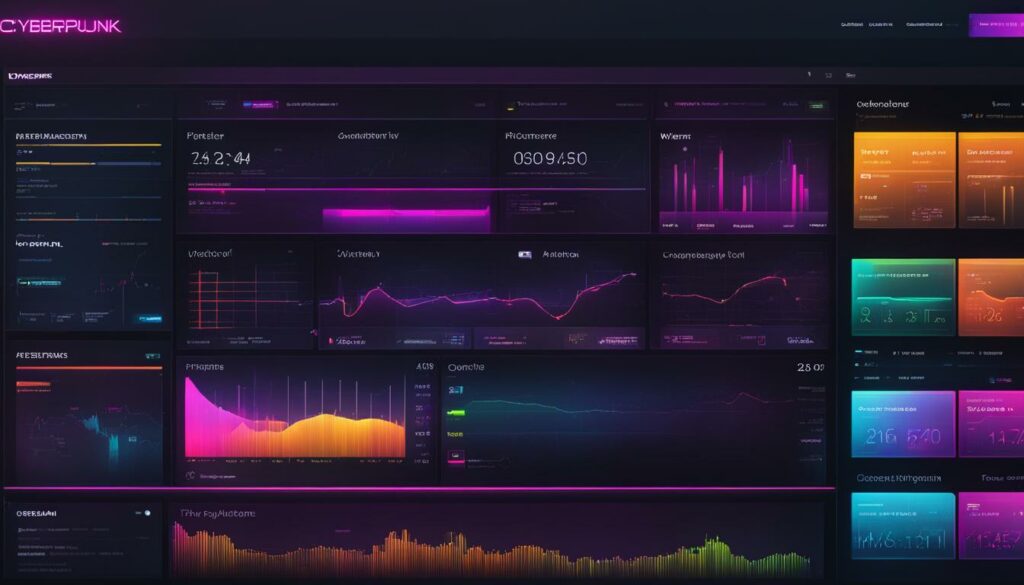In order to ensure that your mobile app runs smoothly and provides the best user experience, it is crucial to optimize your web hosting for mobile apps. By taking the right steps, you can enhance the performance of your mobile app and improve user satisfaction.
When it comes to web hosting for mobile apps, you need to consider factors such as load speed, accessibility, performance monitoring, server latency, and code optimization. These optimizations can make a significant difference in how well your mobile app performs and how satisfied your users are.
To find the best web hosting for mobile apps, look for providers that offer reliability, affordability, security, and easy-to-use features. You want a web hosting service that can handle the unique demands of mobile apps and ensure fast loading times and reliable performance.
When you choose the right web hosting for your mobile app, you can be confident that it will provide the foundation for a successful and high-performing application.
Key Takeaways:
- Optimizing web hosting is essential for improving mobile app performance.
- Factors like load speed, accessibility, and code optimization impact app performance.
- Choose a web hosting provider that offers reliability, affordability, and security.
- Optimized web hosting ensures fast loading times and reliable performance.
- Investing in the right web hosting sets a strong foundation for your mobile app.
The Importance of Web Application Performance
Web application performance is crucial for several reasons. First, it directly impacts the user experience. Slow-loading pages and apps can frustrate users and lead them to abandon the app. Additionally, web performance is a key factor in search engine rankings, with Google stating that site speed is considered in their algorithms. Shorter loading times can also improve conversions and ultimately increase revenue. Therefore, optimizing web application performance is essential for businesses that want to provide a valuable and responsive app experience.
When it comes to web application performance, user experience is at the forefront. Visitors to your app expect fast loading times and smooth navigation. If your app is slow and unresponsive, it can lead to frustration and dissatisfaction, driving users away. On the other hand, a fast and responsive app enhances user satisfaction and encourages them to engage with your app for longer periods of time.
In addition to user experience, web application performance plays a crucial role in search engine ranking. Google and other search engines prioritize fast-loading websites and apps, as this improves the overall user experience. By optimizing your app’s performance, you increase your chances of appearing higher in search engine results pages, driving more organic traffic to your app and ultimately boosting your visibility and reach.
Beyond user experience and search engine ranking, web application performance also impacts conversions and revenue. When your app performs well, users are more likely to take desired actions, such as making a purchase, filling out a form, or subscribing to a service. Conversely, if your app is slow and unresponsive, users may abandon their intended actions, resulting in missed opportunities for conversions and revenue.
To illustrate the impact of web application performance on conversions and revenue, consider the following scenario. A potential customer visits your e-commerce app, looking to purchase a product. However, due to slow loading times and unresponsive features, the customer becomes frustrated and decides to abandon the purchase. As a result, you not only lose that specific sale but also potentially lose a loyal customer who may have made repeat purchases in the future. On the other hand, if your app is optimized for performance, the customer can seamlessly navigate through the app, find the desired product, and complete the purchase, resulting in increased conversions and revenue.
Overall, optimizing web application performance is essential in today’s digital landscape. It not only enhances the user experience but also improves search engine rankings, conversions, and revenue. By prioritizing web performance optimization, businesses can provide a valuable and responsive app experience that drives success.
Factors Affecting Web Application Optimization
When it comes to optimizing web applications, several factors come into play. Understanding these factors is essential for enhancing the performance and user experience of your web app. Let’s take a closer look at the key elements that impact web application optimization:
1. Server Performance
The performance of your server plays a critical role in the overall optimization of your web application. A reliable and robust server ensures that your app functions seamlessly, providing a smooth experience for users. Factors such as server location and server response time can significantly impact page load speeds and user satisfaction.
2. Page Size
The size of your web pages can affect the loading time of your application. Large page sizes can lead to slower loading speeds, which may result in a higher bounce rate and reduced engagement. By optimizing your page size and reducing unnecessary elements, you can improve the overall performance of your web app.
3. Code Optimization
Efficient and clean coding practices are essential for optimizing your web application. Well-structured and optimized code improves the app’s performance, speed, and security. By minimizing code complexity, eliminating redundant code, and adhering to coding best practices, you can enhance the overall efficiency of your web app.
4. CMS Plugins
CMS plugins can offer various functionalities to your web app. However, it’s important to note that using too many plugins, or outdated and faulty plugins, can negatively impact performance. Regularly update your plugins and choose carefully to ensure they are compatible and optimized for your web application.
Incorporating best practices to address these factors can significantly enhance the optimization of your web application, resulting in improved performance, user experience, and ultimately, the success of your app.

10 Pointers for Web App Performance Optimization
When it comes to optimizing your web app’s performance, there are several important factors to consider. By implementing these key strategies, you can ensure that your web app runs smoothly and efficiently, providing a seamless user experience. Here are 10 pointers to help you optimize your web app performance:
- Utilize Performance Metrics: Use performance metrics to identify areas where your web app may be experiencing issues. This will allow you to pinpoint specific areas that need improvement and make targeted optimizations.
- Implement File Caching: File caching is a technique that allows you to store certain files, such as stylesheets and JavaScript files, on the user’s device. This reduces the need for repetitive file downloads and can significantly improve load times.
- Utilize Content Delivery Networks (CDNs): CDNs work by storing your web app’s files on servers located in various geographic locations. This allows users to access your app’s content from a server that is geographically closer to them, reducing latency and improving load times.
- Minimize HTTP Requests: Each HTTP request made by your web app adds to the load time. Minimize the number of requests by combining multiple files into one and optimizing code to reduce the need for excessive requests.
- Optimize Images: Image optimization is crucial for web app performance. Compress images to reduce their file size without sacrificing quality, and consider using responsive images to ensure optimal display on different devices.
- Implement Performance Monitoring: Regularly monitor your web app’s performance using tools like Sematext, Pingdom, or New Relic Browser. These tools can provide insights into areas where your app may be experiencing performance issues, enabling you to make necessary optimizations.
- Consider Browser Extensions: Browser extensions like PageSpeed Insights or YSlow can provide valuable insights into your web app’s performance and offer suggestions for improvement. Install and use these extensions to gain important performance-related information.
- Choose Reliable Web Hosting: Opt for a reliable web hosting service with a fast and stable infrastructure. A dependable hosting provider ensures that your web app remains accessible and performs optimally even during periods of high traffic.
By following these pointers, you can significantly improve your web app’s performance and deliver a better user experience. Remember that optimizing your app is an ongoing process, so continue to monitor performance and make adjustments whenever necessary.
Choosing the Right Tools for Web App Performance Optimization
Selecting the right web app performance monitoring tools is crucial for optimizing web application performance. With a wide range of options available, each offering unique features and benefits, it’s important to choose tools that best suit your business needs. Here are some popular tools to consider:
- Sematext: With Sematext, you can monitor and analyze the performance of your web applications in real-time. It offers comprehensive monitoring capabilities and helps identify and address performance issues efficiently.
- Pingdom: Pingdom is a powerful performance monitoring tool that provides insights into website uptime, page speed, and transaction monitoring. It offers customizable alerting and detailed reports to ensure your web app is running smoothly.
- Uptime Robot: Uptime Robot is a reliable monitoring service that actively checks the availability of your web app. It alerts you instantly in case of any downtime, helping you maintain high uptime and responsiveness.
- TeamViewer Web Monitoring: TeamViewer Web Monitoring allows you to track the performance of your web app from different locations worldwide. Its intuitive interface, customizable alerts, and detailed reporting make it a valuable tool for optimizing performance.
- New Relic Browser: New Relic Browser provides real-time monitoring and analytics for web applications. It helps identify bottlenecks and optimize user experiences with detailed insights into page load times and performance metrics.
- Datadog Synthetics: Datadog Synthetics is a powerful testing and monitoring tool that ensures your web app functions correctly across various scenarios. It allows you to simulate user interactions, monitor API performance, and track real-time metrics.
- Dynatrace: Dynatrace offers advanced application monitoring capabilities, including real user monitoring, synthetic monitoring, and code-level insights. Its AI-powered platform helps detect and resolve performance issues proactively.
- Checkly: Checkly is a modern monitoring tool designed for developers. It enables you to test and monitor critical user flows, validate API responses, and gain valuable insights into performance metrics.
- Calibreapp: Calibreapp is a comprehensive performance monitoring tool that helps you track and optimize your web app’s performance. It offers detailed performance reports, asset optimization suggestions, and collaboration features for teams.
- SolarWinds® AppOptics™: SolarWinds® AppOptics™ is a scalable monitoring platform that provides deep visibility into web app performance. It offers real-time monitoring, alerts, and intuitive dashboards to optimize your application’s performance.
By leveraging these web app performance monitoring tools, you can effectively identify and address performance issues, ensuring your web application runs smoothly and provides an optimal user experience.
Choosing Software to Monitor your Web App
When it comes to monitoring the performance of your web app, selecting the right software is crucial. The right monitoring software can provide you with the necessary insights and data to optimize your web app’s performance and ensure a positive user experience. Here are some key features to consider when choosing web app monitoring software:
- Real-Time Monitoring: Look for software that offers real-time monitoring capabilities. This allows you to track the performance of your web app in real-time, identify issues as they occur, and take immediate action to address them.
- Customizable Alerts: Customizable alerts are essential for staying informed about critical issues affecting your web app’s performance. The software should allow you to set up alerts based on specific performance metrics or thresholds, so you can be notified instantly when something goes wrong.
- Detailed Reporting: Comprehensive and detailed reporting is necessary to gain a deep understanding of your web app’s performance. Look for software that provides insightful reports, with metrics and visualizations that help you identify trends, patterns, and areas for improvement.
- User Feedback: User feedback is invaluable when it comes to understanding the user experience of your web app. Choose a monitoring software that allows you to collect and analyze user feedback, such as ratings, reviews, and comments. This can help you identify usability issues and make necessary improvements.
- Reviews: Before making a decision, read reviews and evaluate the reputation of the monitoring software. Look for feedback from other businesses and users who have used the software to get an idea of its effectiveness, reliability, and ease of use.
By considering these features and factors, you can make a well-informed decision and choose the right software to monitor your web app’s performance. This will enable you to proactively identify and resolve issues, optimize performance, and provide an excellent user experience.
Example of Monitoring Software Comparison Table
| Software | Real-Time Monitoring | Customizable Alerts | Detailed Reporting | User Feedback | Reviews |
|---|---|---|---|---|---|
| Sematext | Yes | Yes | Yes | No | 4.5/5 |
| Pingdom | Yes | Yes | Yes | No | 4/5 |
| Uptime Robot | Yes | Yes | No | No | 4.2/5 |
| TeamViewer Web Monitoring | Yes | No | Yes | No | 3.8/5 |
| New Relic Browser | Yes | Yes | Yes | No | 4.6/5 |
| Datadog Synthetics | Yes | Yes | Yes | No | 4.3/5 |

Mobile Optimization: The Need of the Hour
As the use of mobile devices for browsing and shopping continues to rise, optimizing websites for mobile users has become more crucial than ever. With a growing global mobile user base and mobile traffic surpassing desktop usage, prioritizing mobile optimization is essential for businesses to provide a positive user experience and cater to the needs of mobile users.
One important aspect of mobile optimization is Google’s mobile-first policy. This policy means that Google ranks websites based on their mobile version rather than the desktop version. By following this policy and ensuring that your website is mobile-friendly, you can improve your search engine visibility and reach a wider audience of mobile users.
Mobile optimization also plays a crucial role in user experience. Mobile users have different needs and expectations compared to desktop users, and a mobile-friendly design can enhance their browsing experience. A responsive and mobile-friendly design ensures that your website adapts seamlessly to different screen sizes, providing a visually appealing and user-friendly interface.
Furthermore, mobile optimization helps businesses tap into the vast global mobile user base. According to Statista, the number of smartphone users worldwide is projected to reach 3.8 billion by 2021. By optimizing your website for mobile users, you can tap into this large potential customer base and increase your reach.
To visually illustrate the growth of the global mobile user base, take a look at the table below:
| Year | Number of Mobile Users (in billions) |
|---|---|
| 2016 | 2.6 |
| 2017 | 3.0 |
| 2018 | 3.3 |
| 2019 | 3.5 |
| 2020 | 3.8 |
As you can see, the number of mobile users has steadily increased over the years, highlighting the importance of mobile optimization for businesses.
Mobile optimization not only improves user experience but also boosts engagement and conversion rates. Mobile users are more likely to engage with a website that is fast-loading, easy to navigate, and provides relevant content. By optimizing your website for mobile users, you can increase user engagement and ultimately drive more conversions.
Remember, mobile optimization is not a one-time task but an ongoing process. With the continuous evolution of mobile devices and user expectations, it is crucial to stay updated with the latest mobile design trends and regularly test and optimize your website for optimal performance.
With mobile optimization being the need of the hour, adopting mobile-friendly design practices and following Google’s mobile-first policy are key elements to succeed in today’s digital landscape.

Conclusion
Optimizing web hosting for mobile app performance is crucial for providing a positive user experience and improving the overall performance of web applications. By following best practices such as optimizing code, utilizing caching and CDNs, and choosing the right web hosting service, businesses can ensure that their mobile apps run smoothly and efficiently.
Monitoring web app performance and using the right tools can help identify and address any issues that may arise. There are various web app performance monitoring tools available, including Sematext, Pingdom, Uptime Robot, TeamViewer Web Monitoring, New Relic Browser, Datadog Synthetics, Dynatrace, Checkly, Calibreapp, and SolarWinds® AppOptics™. These tools provide monitoring and analytics capabilities, allowing businesses to identify and address performance issues.
In the current digital landscape, where mobile usage continues to dominate, mobile optimization is essential. With the global mobile user base growing rapidly and mobile traffic surpassing desktop usage, it is necessary to prioritize mobile optimization. This includes following Google’s mobile-first policy and adopting mobile-friendly design practices. By optimizing web hosting for mobile app performance and prioritizing mobile optimization, businesses can provide a seamless user experience and stay competitive in this mobile-driven era.
FAQ
Q: What is the importance of optimizing web hosting for mobile apps?
A: Optimizing web hosting for mobile apps is important to ensure a smooth user experience and improve overall app performance.
Q: How does web application performance impact the user experience?
A: Slow-loading pages and apps can frustrate users and lead them to abandon the app, while faster load times can improve the user experience.
Q: What factors can affect web application optimization?
A: Factors that can affect web application optimization include server performance, server location, page size, and code-related issues.
Q: What are some pointers for optimizing web app performance?
A: Some pointers for optimizing web app performance include using performance metrics, implementing file caching, utilizing content delivery networks, and optimizing images for faster loading.
Q: Which tools can be used to monitor web app performance?
A: Some popular tools for monitoring web app performance include Sematext, Pingdom, Uptime Robot, TeamViewer Web Monitoring, New Relic Browser, Datadog Synthetics, Dynatrace, Checkly, Calibreapp, and SolarWinds® AppOptics™.
Q: How should businesses choose the right software to monitor their web app?
A: Businesses should consider features such as real-time monitoring, customizable alerts, detailed reporting, and customer feedback when choosing software to monitor their web app.
Q: Why is mobile optimization important?
A: Mobile optimization is important because the global mobile user base is rapidly growing, and mobile traffic has surpassed desktop usage. Prioritizing mobile optimization is crucial for providing a positive user experience and catering to the needs of mobile users.
Source Links
- https://code.pieces.app/blog/optimize-web-application-performance
- https://www.linkedin.com/pulse/enhancing-user-experience-how-optimize-your-website-mobile-users-ti7ec?trk=article-ssr-frontend-pulse_more-articles_related-content-card
- https://www.dreamhost.com/blog/how-to-optimize-your-site-for-mobile/












